Showing Spotlights 281 - 288 of 338 in category All (newest first):
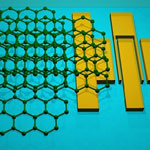 Gallium Nitride (GaN) is a semiconductor material commonly used in bright light-emitting diodes since the 1990s, which are now found in traffic lights and solid-state lighting. Thanks to its wide band gap, this very hard semiconductor material also finds applications in optoelectronic, high-power and high-frequency devices. However, a severe problem that afflicts high-power GaN electronic and optoelectronic devices is self-heating and the difficulties of heat removal. Researchers have now found an unusual solution for the thermal management problem of gallium-nitride technology: They demonstrated that thermal management of GaN transistors can be substantially improved via introduction of alternative heat-escaping channels implemented with graphene multilayers.
Gallium Nitride (GaN) is a semiconductor material commonly used in bright light-emitting diodes since the 1990s, which are now found in traffic lights and solid-state lighting. Thanks to its wide band gap, this very hard semiconductor material also finds applications in optoelectronic, high-power and high-frequency devices. However, a severe problem that afflicts high-power GaN electronic and optoelectronic devices is self-heating and the difficulties of heat removal. Researchers have now found an unusual solution for the thermal management problem of gallium-nitride technology: They demonstrated that thermal management of GaN transistors can be substantially improved via introduction of alternative heat-escaping channels implemented with graphene multilayers.
May 10th, 2012
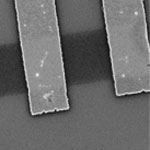 It has been known for some time that graphene can be used for detection of individual gas molecules adsorbed on its surface - a graphene sensor can detect just a single molecule of a toxic gas. However, the extremely high sensitivity of graphene does not necessarily translate into its selectivity to various molecules. In other words, it can be detected that some molecules attached to the graphene surface change the resistivity of a graphene field-effect transistor but one cannot say what kind of a molecules have attached. Scientists have therefore thought that truly selective gas sensing with graphene devices requires the functionalization of graphene surface with some agents specific for different gas molecules. In new research, though, scientists have now found that chemical vapors change the noise spectra of graphene transistors. The noise signal for each gas is reproducible, opening the way for practical reliable and simple gas sensors made from graphene.
It has been known for some time that graphene can be used for detection of individual gas molecules adsorbed on its surface - a graphene sensor can detect just a single molecule of a toxic gas. However, the extremely high sensitivity of graphene does not necessarily translate into its selectivity to various molecules. In other words, it can be detected that some molecules attached to the graphene surface change the resistivity of a graphene field-effect transistor but one cannot say what kind of a molecules have attached. Scientists have therefore thought that truly selective gas sensing with graphene devices requires the functionalization of graphene surface with some agents specific for different gas molecules. In new research, though, scientists have now found that chemical vapors change the noise spectra of graphene transistors. The noise signal for each gas is reproducible, opening the way for practical reliable and simple gas sensors made from graphene.
Apr 26th, 2012
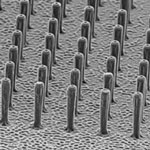 Graphene with its distinctive band structure and unique physiochemical properties - such as exceptionally low intrinsic electrical resistivity, high surface area, rapid electrode kinetics and good mechanical properties - is considered an attractive material for analytical electrochemistry. However, one of the key technical challenges for the use of graphene as functional material in device applications is the integration of nanoscale graphene onto micro- or millimeter sized sensing platforms. With a new methodology, a team from Florida International University was able to integrate graphene onto three-dimensional (3D) carbon microstructure arrays with good uniformity and controllable morphology.
Graphene with its distinctive band structure and unique physiochemical properties - such as exceptionally low intrinsic electrical resistivity, high surface area, rapid electrode kinetics and good mechanical properties - is considered an attractive material for analytical electrochemistry. However, one of the key technical challenges for the use of graphene as functional material in device applications is the integration of nanoscale graphene onto micro- or millimeter sized sensing platforms. With a new methodology, a team from Florida International University was able to integrate graphene onto three-dimensional (3D) carbon microstructure arrays with good uniformity and controllable morphology.
Apr 24th, 2012
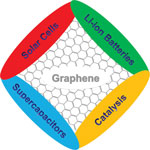 Graphene-based materials are emerging as highly attractive materials for real applications, especially in the area of energy conversion and storage. There are four major energy-related areas where graphene will have an impact: solar cells, supercapacitors, lithium-ion batteries, and catalysis for fuel cells. A recent review gives a brief overview of the recent research concerning chemical and thermal approaches toward the production of well-defined graphene-based nanomaterials and their applications in energy-related areas. But before graphene-based nanomaterials and devices find widespread commercial use, two important problems have to be solved: one is the preparation of graphene-based nanomaterials with well-defined structures, and the other is the controllable fabrication of these materials into functional devices.
Graphene-based materials are emerging as highly attractive materials for real applications, especially in the area of energy conversion and storage. There are four major energy-related areas where graphene will have an impact: solar cells, supercapacitors, lithium-ion batteries, and catalysis for fuel cells. A recent review gives a brief overview of the recent research concerning chemical and thermal approaches toward the production of well-defined graphene-based nanomaterials and their applications in energy-related areas. But before graphene-based nanomaterials and devices find widespread commercial use, two important problems have to be solved: one is the preparation of graphene-based nanomaterials with well-defined structures, and the other is the controllable fabrication of these materials into functional devices.
Apr 18th, 2012
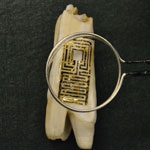 Early detection of pathogenic bacteria is critical to prevent disease outbreaks and preserve public health. This has led to urgent demands to develop highly efficient strategies for isolating and detecting this microorganism in connection to food safety, medical diagnostics, water quality, and counter-terrorism. A team of scientists has now developed a novel approach to interfacing passive, wireless graphene nanosensors onto biomaterials via silk bioresorption. The nanoscale nature of graphene allows for high adhesive conformality after biotransfer and highly sensitive detection. The team demonstrates their nanosensor by attaching it to a tooth for battery-free, remote monitoring of respiration and bacteria detection in saliva.
Early detection of pathogenic bacteria is critical to prevent disease outbreaks and preserve public health. This has led to urgent demands to develop highly efficient strategies for isolating and detecting this microorganism in connection to food safety, medical diagnostics, water quality, and counter-terrorism. A team of scientists has now developed a novel approach to interfacing passive, wireless graphene nanosensors onto biomaterials via silk bioresorption. The nanoscale nature of graphene allows for high adhesive conformality after biotransfer and highly sensitive detection. The team demonstrates their nanosensor by attaching it to a tooth for battery-free, remote monitoring of respiration and bacteria detection in saliva.
Mar 29th, 2012
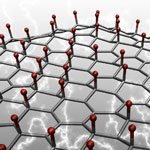 One of the greatest challenges in harnessing the power of nanotechnology is achieving dynamic control of mechanical, electronic, optical and chemical properties of nanoscale structures and devices. Dynamic control can be achieved through the use of piezoelectric materials. These are materials where applying a mechanical strain results in an electrical voltage or conversely, application of an electric field induces mechanical deformation. While piezoelectricity has mainly been shown for 3D bulk materials, the piezoelectric effect has also been demonstrated and exploited at the nanoscale. Researchers have now demonstrated through density functional theory calculations that piezoelectricity can be engineered into non-piezoelectric graphene by selective surface adsorption of atoms on only one side, which breaks inversion symmetry.
One of the greatest challenges in harnessing the power of nanotechnology is achieving dynamic control of mechanical, electronic, optical and chemical properties of nanoscale structures and devices. Dynamic control can be achieved through the use of piezoelectric materials. These are materials where applying a mechanical strain results in an electrical voltage or conversely, application of an electric field induces mechanical deformation. While piezoelectricity has mainly been shown for 3D bulk materials, the piezoelectric effect has also been demonstrated and exploited at the nanoscale. Researchers have now demonstrated through density functional theory calculations that piezoelectricity can be engineered into non-piezoelectric graphene by selective surface adsorption of atoms on only one side, which breaks inversion symmetry.
Mar 22nd, 2012
 Graphene is an excellent conductor of heat and might be an ideal material for thermal management in nanoelectronics. In field-effect transistors or interconnects most of the heat propagates directly below the graphene channel in the direction of the heat sink, that is, the bottom of a silicon wafer. For this reason, the highly thermally resistive silicon layers act as a thermal bottleneck, preventing the full utilization of graphene's excellent intrinsic properties. The breakdown current density in typical graphene devices is a hundred times larger than the fundamental limit in metals, which is set by electromigration. Researchers wanted to see if we can push the breakdown current density in graphene even further by better removal of dissipated heat. They managed to do it with the help of high-quality synthetic diamond. The graphene transistors or interconnects on synthetic diamond can sustain current densities which are a thousand times larger than in metals.
Graphene is an excellent conductor of heat and might be an ideal material for thermal management in nanoelectronics. In field-effect transistors or interconnects most of the heat propagates directly below the graphene channel in the direction of the heat sink, that is, the bottom of a silicon wafer. For this reason, the highly thermally resistive silicon layers act as a thermal bottleneck, preventing the full utilization of graphene's excellent intrinsic properties. The breakdown current density in typical graphene devices is a hundred times larger than the fundamental limit in metals, which is set by electromigration. Researchers wanted to see if we can push the breakdown current density in graphene even further by better removal of dissipated heat. They managed to do it with the help of high-quality synthetic diamond. The graphene transistors or interconnects on synthetic diamond can sustain current densities which are a thousand times larger than in metals.
Feb 20th, 2012
 Noble metal nanoparticles such as gold, silver or platinum are widely used by scientists to develop novel applications in sensing, energy, spectroscopy, and catalysis. For instance, the combination of metal nanoparticles and carbon nanomaterials - graphene and nanotubes - has met with great interest in the area of biosensor applications as well as composite fabrication for light-energy conversion. In these applications, researchers make use of the formation of organic/inorganic hybrid nanosystems by incorporating metal nanoparticles in or onto the graphitic structures of carbon nanotubes or graphene. Researchers have now discovered a novel phenomenon whereby graphene can be catalytically transformed into carbon nanotubes by gold nanoparticles at relatively low temperatures.
Noble metal nanoparticles such as gold, silver or platinum are widely used by scientists to develop novel applications in sensing, energy, spectroscopy, and catalysis. For instance, the combination of metal nanoparticles and carbon nanomaterials - graphene and nanotubes - has met with great interest in the area of biosensor applications as well as composite fabrication for light-energy conversion. In these applications, researchers make use of the formation of organic/inorganic hybrid nanosystems by incorporating metal nanoparticles in or onto the graphitic structures of carbon nanotubes or graphene. Researchers have now discovered a novel phenomenon whereby graphene can be catalytically transformed into carbon nanotubes by gold nanoparticles at relatively low temperatures.
Feb 8th, 2012
 Gallium Nitride (GaN) is a semiconductor material commonly used in bright light-emitting diodes since the 1990s, which are now found in traffic lights and solid-state lighting. Thanks to its wide band gap, this very hard semiconductor material also finds applications in optoelectronic, high-power and high-frequency devices. However, a severe problem that afflicts high-power GaN electronic and optoelectronic devices is self-heating and the difficulties of heat removal. Researchers have now found an unusual solution for the thermal management problem of gallium-nitride technology: They demonstrated that thermal management of GaN transistors can be substantially improved via introduction of alternative heat-escaping channels implemented with graphene multilayers.
Gallium Nitride (GaN) is a semiconductor material commonly used in bright light-emitting diodes since the 1990s, which are now found in traffic lights and solid-state lighting. Thanks to its wide band gap, this very hard semiconductor material also finds applications in optoelectronic, high-power and high-frequency devices. However, a severe problem that afflicts high-power GaN electronic and optoelectronic devices is self-heating and the difficulties of heat removal. Researchers have now found an unusual solution for the thermal management problem of gallium-nitride technology: They demonstrated that thermal management of GaN transistors can be substantially improved via introduction of alternative heat-escaping channels implemented with graphene multilayers.
 Subscribe to our Nanotechnology Spotlight feed
Subscribe to our Nanotechnology Spotlight feed





